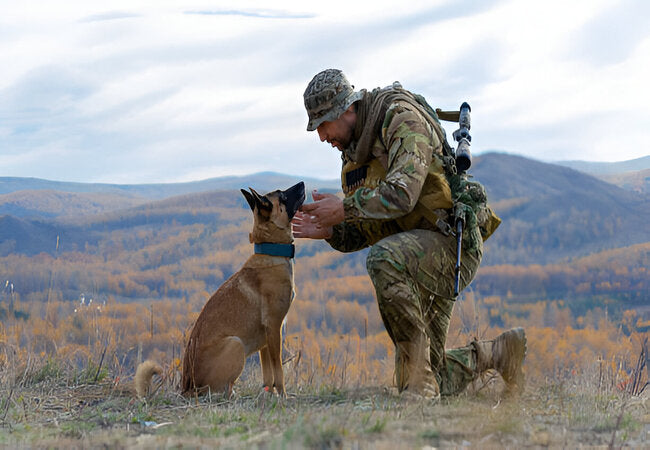Military Working Dogs & Canine PTSD in 2025 – Vet‑Approved Guide on Detection, Care & Support 🐾🎖️

In this article
Military Working Dogs & Canine PTSD in 2025 – Vet‑Approved Guide on Detection, Care & Support 🐾🎖️
By Dr. Duncan Houston BVSc
Our military working dogs are true heroes—sniffing out danger, detecting explosives, and saving lives on the front lines. But these brave companions can carry the invisible wounds of war, too. Canine post‑traumatic stress disorder (C‑PTSD) affects many war‑deployed dogs, causing anxiety, fear, avoidance, and even aggression long after their service has ended. In this veterinary‑approved 2025 guide, we delve into what causes C‑PTSD, how to recognize it, rehabilitation methods, and compassionate support systems designed for our four‑legged veterans. Let’s honour their service and help them heal. 🇺🇸🐶
1. 🇺🇸 What Is Canine PTSD in MWDs?
C‑PTSD is a trauma-based anxiety disorder seen in military working dogs (MWDs) exposed to combat—explosions, gunfire, chaos—often even after a single event. Like human PTSD, symptoms can persist for years without early intervention.
2. How Common Is It?
- An estimated 5–10% of deployed U.S. MWDs show signs of PTSD post-deployment.
- Some kennels report 30% of retired MWDs and as many as 50% of contractor dogs display C‑PTSD symptoms.
3. What Causes C‑PTSD?
- Exposure to traumatic combat scenarios—explosions, ambushes, heavy fire.
- Repetitive stressful missions without adequate recovery time.
- Traumatic training methods without emotional decompression.
4. Signs & Symptoms to Look For
- ⬆️ Over‑ or under‑reactivity to stimuli (loud noises, sudden movements).
- Depression or disinterest in work/play.
- Strong avoidance of triggers like uniforms, noise, or vehicles.
- Changes in handler bond—withdrawal, defensiveness, aggression.
- Escape attempts, panicked behavior, hypervigilance.
5. Diagnosis & Early Intervention
Veterinary behaviourists diagnose C‑PTSD using behavioural histories, assessments, and screenings conducted post-deployment or pre‑duty in kennels. Early detection allows faster treatment and better outcomes.
6. Treatment & Rehabilitation
A. Behavior Modification & Desensitization
- Controlled exposure to calming sounds, stepwise reintroduction to environments.
- Positive reinforcement and building resilience through safe training.
B. Environmental Enrichment & Decompression Therapy
- Stable home routines, sensory enrichment (scent, chew toys), quiet “down” locations.
- Gradual kenneling reductions with supportive handlers during early retirement.
C. Medical & Pharmacological Interventions
Under veterinary supervision, medications like SSRIs, anxiolytics, and supplements may reduce symptoms. Long‑term success combines both therapy and medical support.
7. Support Systems & Rehoming Programs
Organizations like Mission K9 Rescue, K9s For Warriors, and Bravehound specialize in rehabilitating MWDs with PTSD and placing them in supportive homes.
8. The Handler’s Role & Ongoing Care
- Maintain a predictable routine—rest, training, social time.
- Use consistent, gentle training and avoid punishment around triggers.
- Allow time for decompression post-missions or noisy environments.
- Record behaviour and progress—setbacks can signal needed adjustments.
9. Benefits of Service Dogs for Veterans
Service dogs also assist veterans with PTSD: they reduce anxiety, improve social engagement, and provide emotional regulation.
10. Scientific Evidence & Research
- Research shows that veterans with PTSD service dogs report lower symptoms, anxiety, and depression than those waiting for placement.
- MRI and behavioral studies continue to improve the selection and training of suitable therapy/service dogs.
11. What Handlers & Vets Can Do
- Screen dogs post-deployment to catch early signs.
- Create recovery plans involving behaviourists, enrichment, and decompression.
- Partner with non-profits for rehoming or continued service roles.
- Document long-term outcomes for continuous improvement.
12. When C‑PTSD Isn’t Fully Resolved
C‑PTSD isn’t always fully curable—but it can be managed. Many MWDs retire into loving homes where, with patience and professional support, they flourish and find calm purpose.
📱 Ask A Vet App 2025 Support
With the Ask A Vet app, handlers and vets can:
- 📹 Upload behavioural footage for veterinary review.
- 🧩 Get tailored C‑PTSD care plans blending training and medical support.
- 💬 Track progress and adjust rehabilitation strategies over time.
- 📚 Access guidance on rehoming, service dog training, or decompression programs.
Support and compassion make healing possible for our canine heroes. 🐾📲
❤️ Final Thoughts
Military working dogs carry the burdens of battle alongside their human partners. Canine PTSD is real—but with early detection, professional care, enriched homes, and unwavering love, these trusted heroes can heal and thrive. Let’s give back to them the same courage they gave us. 🐶🎖️
Need tailored support? Visit AskAVet.com or download the Ask A Vet app for expert healing plans, training strategies, and compassionate care for canine veterans.






